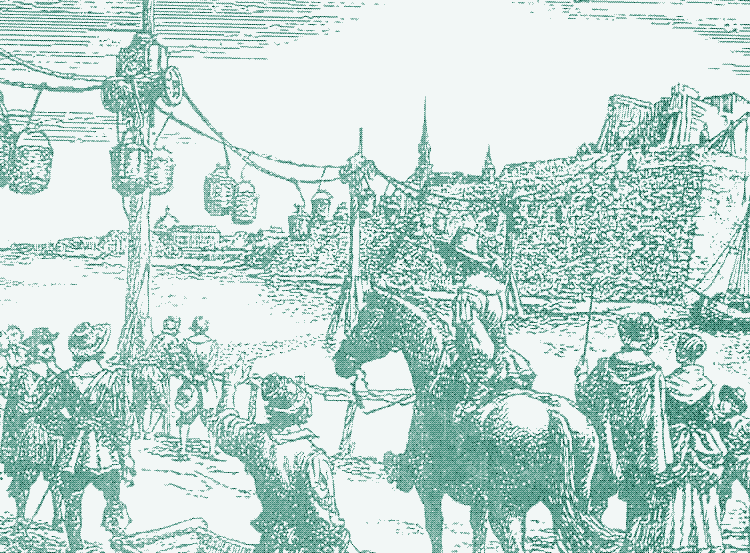
These days, we use them almost exclusively to transport skiers and snowboarders up snow slopes, but before the 1940s, aerial ropeways were a common means of cargo transport, not only in mountainous regions but also on flat terrain, with large-scale systems already built during the Middle Ages.
Aerial ropeways can be fully or partly powered by gravity, and some deliver excess power that can be utilized to generate electricity or to drive cranes or machinery in nearby factories. Some innovative systems have been constructed in recent years.
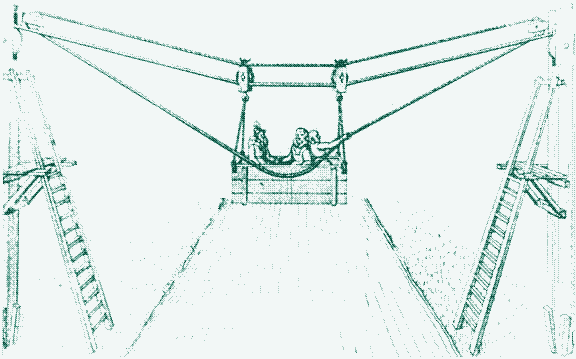
Before we start, it is important to note that aerial ropeways (also known as aerial tramways or cableways) can be divided in two groups: monocable and bicable mechanisms. In a monocable system, one endless rope serves to both support and move the carriers in transit. In a bicable (or tricable) system, separate ropes sustain these functions: one or two static support ropes, the “carrying ropes” or “track cables”, and one or two light travelling “haul ropes”.
Ancient and medieval ropeways were of both variety, while modern ropeways (from the 1850s onwards) were initially exclusively monocable systems. Later, bicable systems took over almost completely. At the end of the 19th century, both ropeway methods were also applied to canal transportation (see the article on trolley canal boats), with monocable systems used for cable trains. Bicable mechanisms are much better suited if the track spans larger distances and/or has steeper grades.
If only one endless rope would be used on a track which includes a long span or a steep grade, it would become necessary to make the entire double length of the moving rope strong enough for the special strain that appears on that spot. Increasing the size of the rope affects the dimensions of the supports, sheaves and other fixtures throughout the line, adding to the costs. In a bicable system, the stationary carrying cable can be locally graduated to the strains it has to bear.
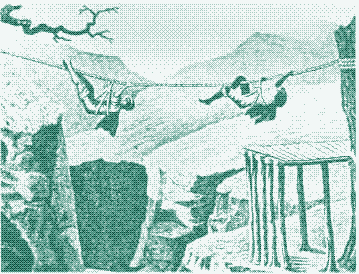
Ropeways in ancient times
Ropeways have been used for more than 2,000 years, transporting both passengers and goods. The first sign of their use comes from the rugged Asiatic countries of China, India and Japan, where it is speculated that they may have been in operation since 250 BC. Men used rope to cross ravines, rivers and river-gorges, initially transferring themselves, hand over hand, with the body suspended by a crude harness. The harness eased the load and allowed a rest as the loop was slid along the rope track.
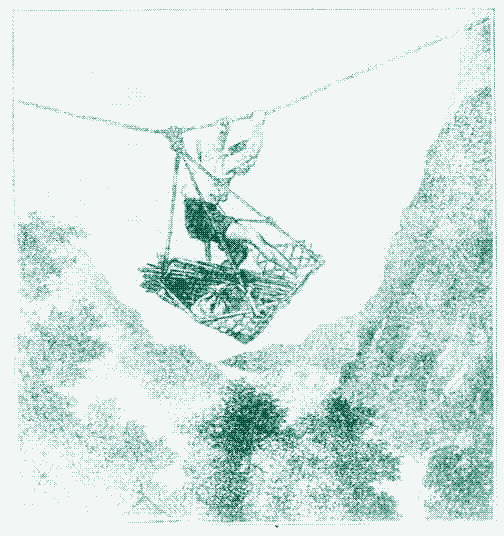
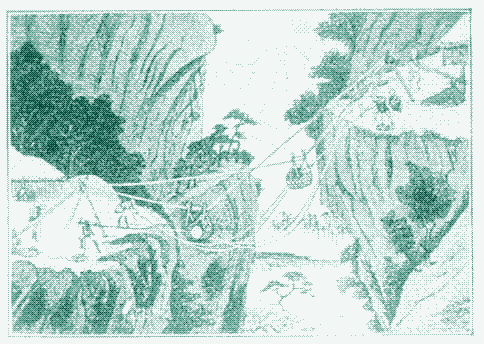
The next application was to pull oneself back and forth in a basket or cradle, usually with a few belongings in tow. This was made possible by means of thinner cords fixed to the front and the back of the basket, or by gravity in case the arrival point was at a lower height than the starting point. The empty sling or basket was then drawn back to its original position by a smaller cord attached to the back as before.
Sometimes, the rope was threaded through a hollow piece of bamboo before being attached, so that the person could slide down the rope without burning their hands. All that was needed to build a ropeway was a rope, knots to tie the rope to a rock or tree or anchor on both sides, and a bow and arrow to shoot the rope across. After the invention of the crossbow by the Chinese, heavier cables could be shot over longer distances. Sometimes the rope was supported on simple wooden trestles.
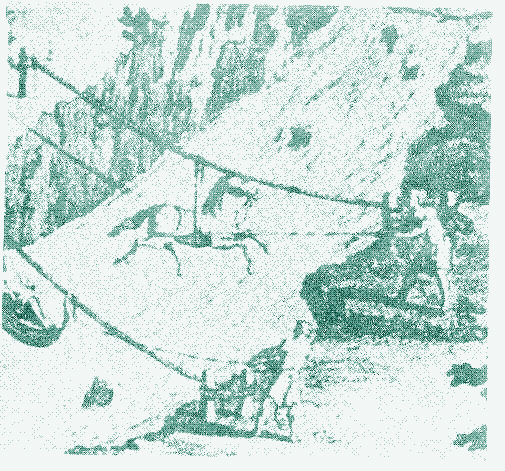
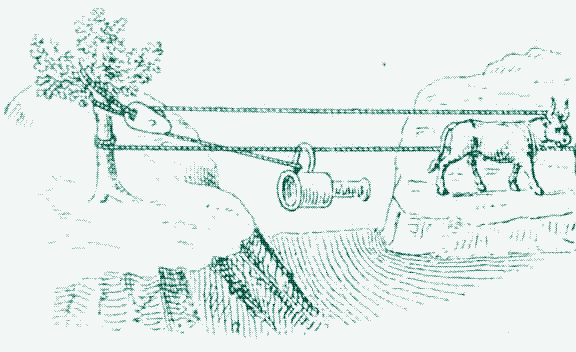
Ropeways were also used to transport pack animals. Inversely, pack animals were sometimes used to pull the ropeway. These early aerial ropeways were the forerunners of later technologies such as the suspension bridge and the elevator. They were also the closest approach to aerial navigation at the time.
Ropeways in the Middle Ages
One of the first mention of ropeways in medieval times appears in the “Taiheiki”, a Japanese historical epic written in the late 14th century. It relates how a Japanese emperor escaped via ropeway over a valley when surrounded by enemy forces. In Europe, initial reference to the use of ropeways can be found in Bellifortis, a weapons catalogue from 1405. A 1411 book is the first to show a drawing of a ropeway.
Between 1411 and 1440, when technologies such as water mills, windmills and harbour cranes became increasingly popular, references to both monocable and bicable operations increased. In South America, aerial ropeways to transport gold have been reported as far back as 1536.
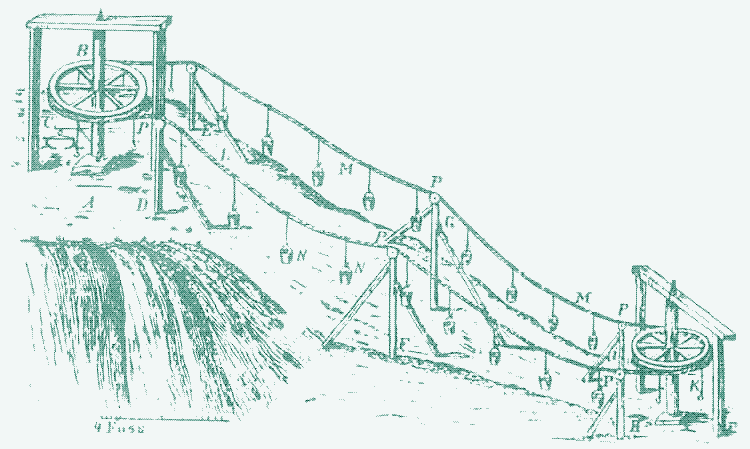
The 17th century saw an increase in design sophistication. Venetian Fausto Veranzio illustrated a refined bicable passenger ropeway in the “Machinae novae”, published in 1615 and 1617. It consisted of a wooden box in which the passengers rode, travelling on pulleys over a fixed rope (second picture from the start). The vehicle was propelled over the river by the occupants pulling themselves along by means of this slack loop. Dutchman Wybe Adam erected a successful large-scale operational system in 1644, which is described in the Danzig Chronicles (picture introduction and picture below).

Adam engineered a continuously circulating ropeway to carry the earthworks material in baskets for a hilltop fortress in Gdansk/Danzig. Ropeways were also constructed by monasteries built high on pinnacles, where they were used to lift supplies and visitors.
Ropeways from the 1850s onwards
From about 1650 to 1850, no further progress was made. The technology had reached its maximum potential at the time, limited by the strength of the available ropes. This all changed with the arrival of the much stronger wire rope in the mid-nineteenth century, which led to the most successful period of aerial ropeways in history. Another breakthrough was the standard coupling designed in the early 1870s by the Austrian von Obach, which allowed the cars to be disengaged and reattached to the trackway. Last but not least, new power sources appeared: first steam engines, then electric motors.
Motive power
Until the end of the nineteenth century, aerial tramways had been powered by humans (sometimes using a windlass or a treadwheel), by animals (mostly gins worked by horses or mules), by waterwheels and/or by gravity.
The last option was (and is) only available in mountainous areas: the descending carriers deliver all or part of the necessary power to haul up the ascending carriers. If the descending cargo is sufficiently heavier than the ascending cargo, and the angle of descent is great enough, the ropeway could be kept running without any additional power input, making it a full-fledged zero emission transport mode. The speed of the descending carriages was governed by means of hand or water powered brakes.
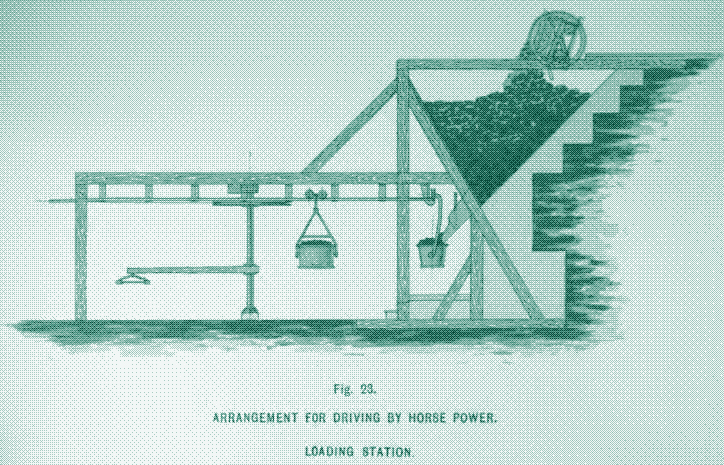
Even when the ascending load was heavy, gravity could be used to transport cargo up the mountain; where water was available at the highest point of the ropeway, it was possible to run materials up alone, employing the descending carrier as a counter-balance filled with water. The system is reminiscent of those used by some early 1900 cable trains.
Net producer of energy
In some gravity powered lines, where the surplus power delivered by the descending cargo was larger than the power required to haul up the ascending carriages, the cableway could be a net producer of energy. Power could be taken off at any point along the track and utilized to drive nearby machinery, for instance driving ore crushers, pumps or sawmills.
A ropeway thus offered the additional possibility of powering neighbouring factories solely by gravity. Before the arrival of electricity, this excess energy was transmitted by mechanical means (wire ropes). Present-day cargo ropeways (see further below) use the excess power to generate electricity.
Extremely efficient
The introduction of electricity as a power generator did not make aerial ropeways unsustainable - far from it. An electrically powered aerial ropeway is one of the most efficient means of transportation available.
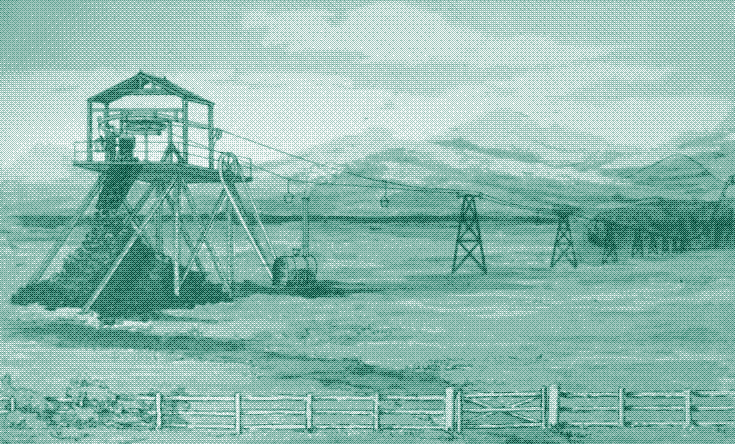
It offers all the advantages of electric transmission (energy-efficient, relatively silent, power can be produced by renewable sources) while eliminating the many problems that come with batteries and charging stations (as is the case with electric cars). In mountainous regions, the electric motor can be assisted by gravity power from the descending carriers, further improving efficiency.
Furthermore, an aerial tramway offers some additional benefits in power consumption compared to other sustainable options such as cargo trains, cargo trams (streetcars) or trolleytrucks. Firstly, energy delivery is more efficient with a fixed electric propulsion system in a single terminal than with transmission over large distance by wire. Secondly, because there is no interference with surface traffic, a constant speed can be maintained, again improving energy efficiency.
Applications of cargo ropeways
Comparatively, few aerial ropeways were built for passenger transportation at the turn of the 20th century, where their primary function was solidified as a means for cargo transportation. Applications were many and diverse, and they occurred all over the world.
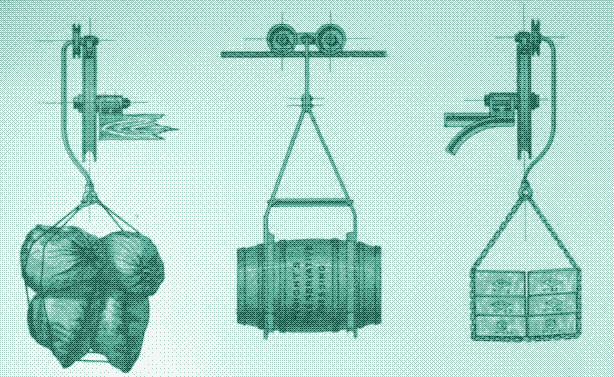
There is no information to be found on the total amount of ropeways that were once in existence, but some sketchy bits of data give us an idea. A source from 1899 names 900 aerial ropeways of a certain technical type in operation worldwide. A product catalog from 1909, still well before the heydays of cargo ropeways, names a figure of 2,000 ropeways worldwide of a certain brand (the Bleichert system), aggregating over 1300 miles in length and transporting 160 million tons annually. Evidently, this was not an obscure technology.
Warfare
Early modern ropeway technology was led by the Europeans, particularly Germany and the Alpine countries - Austria, Switzerland, France and Italy. Aerial ropeways were extensively used for warfare in the Alps between the early 1900s and 1945. Italy used ropeways in the war against Turkey in 1908. During World War I and World War II, aerial ropeways were widely used in the mountain battles between Italy and Austria. Almost 2,000 ropeways were operated by the Italians and over 400 by the Austrians, with most of them being portable.
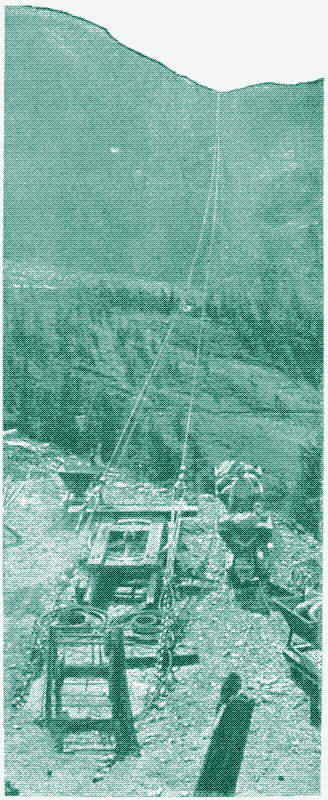
They could quickly be disassembled, moved using pack animals, and assembled somewhere else. Military ropeways were used to reinforce difficult terrain with troops, supplies, howitzers, ammunition and fortification building materials. They were also a short term solution for destroyed bridges and other water crossings, or to lower casualties to hospitals in stretcher carriages (as an alternative to specially equipped pack horses).
Mining
Many cargo cableways were utilized for mining purposes - the first ropeways in the US were for transporting materials when mining in the West was booming. There are many references to ropeways that carried ores (gold, silver, iron, copper), coal, stone, slate, clay, sand, granite, quartz, lime, phosphate rock and brownstone. These goods were usually transported from the mine to a crusher, a railway, a ship or (in the case of coal) a steam engine. Terminals could be set up on a short section of rail, and gradually moved towards the other terminal as the material was removed from before it.
Agriculture
Another important application was the carriage of agricultural products: fruits (like bananas), cereals (like wheat), and other plantation produce like cotton, tea-leaf or sugar cane. These goods were mostly transported from the fields to a mill or railway station. Aerial ropeways were in use on sugar plantations in Demerara, Jamaica, Mauritius, Martinique, St. Kitts, Guatemala, Australia and elsewhere, for the delivery of canes to the crushing mills.
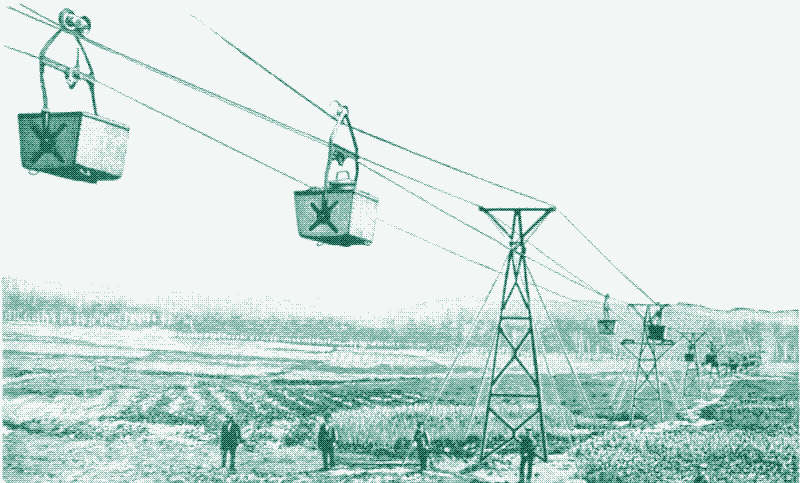
The arrangement shown below was extensively adopted in Mauritius: several wire ropeways driven from the same point discharged on the same cane carrier. A great advantage was that the canes were delivered in a continuous stream direct on to the cane carriers and in quantities that were at no time large enough to demand redistribution in feeding the mill - somewhat similar to today’s just-in-time principle. Only one man took care of the discharge of the carriers.

In many cases an agricultural ropeway was employed in combination with cartage, the canes being brought to certain points along the line by the carts. Ropeways were used for the carriage of beetroot to the sugar factories, in Holland for instance, where the system was used on flat land.
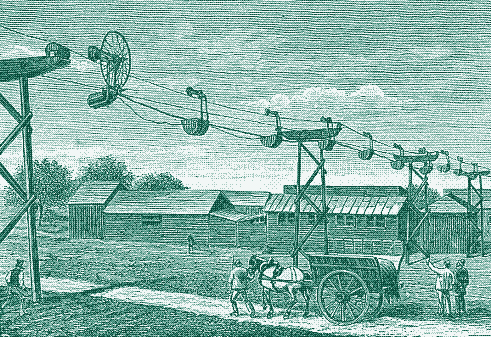
Wood products
The technology was popular for the transport of wood and wood products: logwood, cordwood, sawed timber, charcoal, wood pulp, paper pulp and paper. These were usually transported from a forest to a sawmill or from a sawmill to a railway station. Aerial tramways were applied by builders to convey bricks and materials to the desired points. A ropeway could carry cement from the kilns to the works, and the empty carriers could be used for conveying up coal to the kilns.
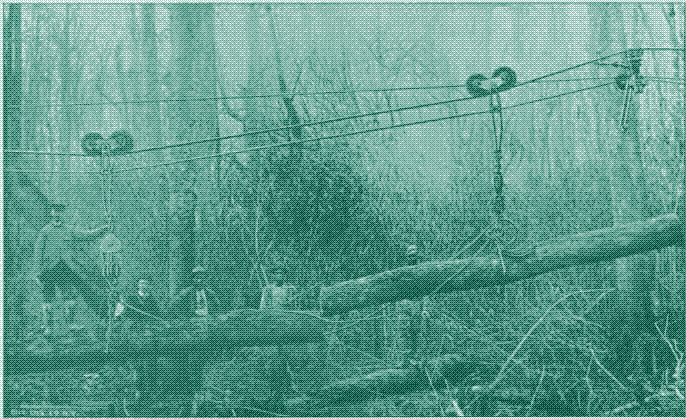
Factories
Another application was the transport of materials within factories - this could be anything, from manufacturer’s supplies, to refuse, materials in process of manufacture, merchandise of all kinds, and particularly products requiring careful manipulation, such as explosives, liquids or glassware. The ropeways in factories were generally short, and the cables could be frequently supported at many points from brackets fixed to the walls of adjacent buildings, saving costs.
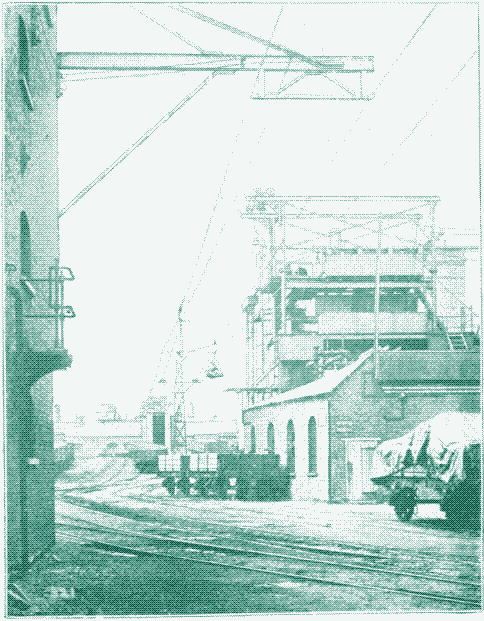
Ropeways were in operation in many print works, linoleum works, mills and other factories. Examples were at artificial manure works near London (the line passed over buildings, dwelling-houses and yards full of workmen) and linoleum works near Middlesex (where the line - driven by water power - passed over a river and many of the workshops and roofs).
Ropeways were used for connecting lines of railway at opposite banks of rivers where bridge building would be unduly costly or difficult. One of these lines was constructed to pick up wagons with their loads, traverse and put them on track at the other side and vice versa. On a much smaller scale, at the end of the 19th century, miniature wire ropeways were introduced in shops for transporting cash.
Harbours
In manufacturing establishments, cableways were operated to distribute material taken from boats or cars to certain storing places in the yards. Aerial ropeways were used by ship owners for the loading and unloading of their cargoes and/or for the bunkering of fuel (coal for the steam engine).
Ropeways provided a means of forming piers for loading and discharging materials when ships and lighters were forced to lie at some distance from the shore because of the shallowness of the water.
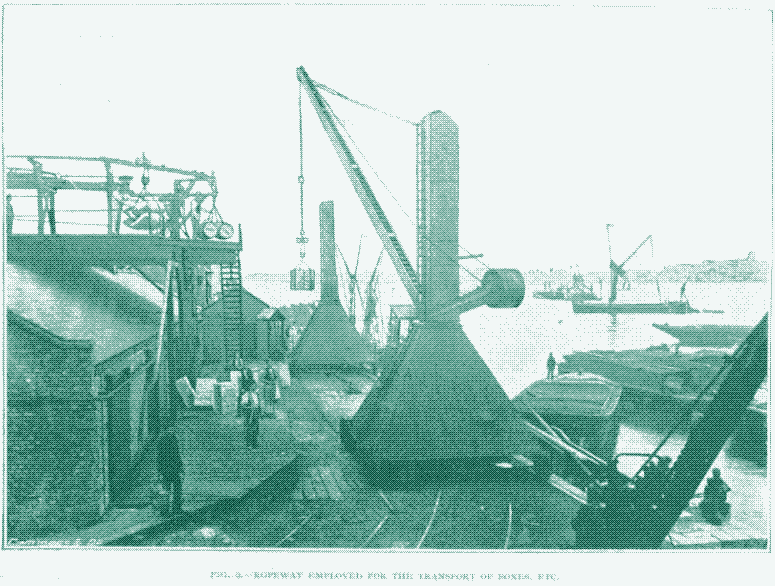
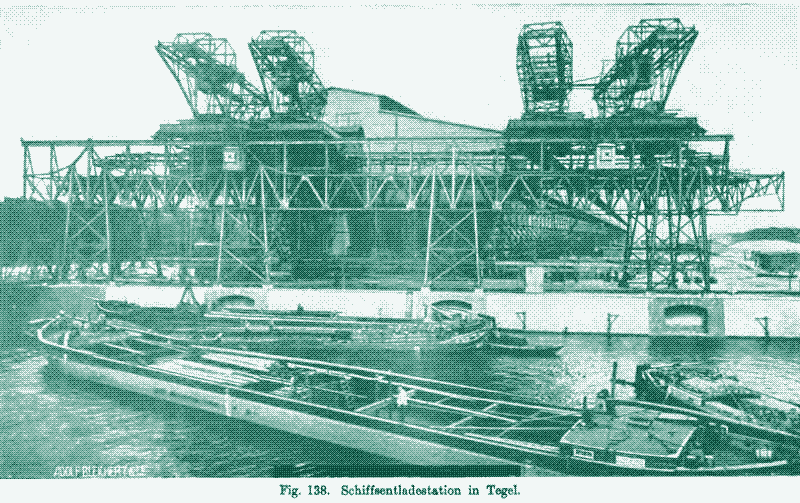
One of these ropeway piers, at the Cape de Verde Islands, measured 1200 feet (365 metres) in length, of which 960 feet extended along the beach, and about 240 feet at right angles to the longer section to the end of the pier, where the coal was received and dispatched. The ropeway carried 15 to 25 tons per hour in either direction, and the motion of the rope was also utilized in working cranes at each terminal for raising or lowering coal. All this was powered by a 16 HP steam engine. The erection of the site took a mere three months. Similar installations were built in New Zealand and South Africa.
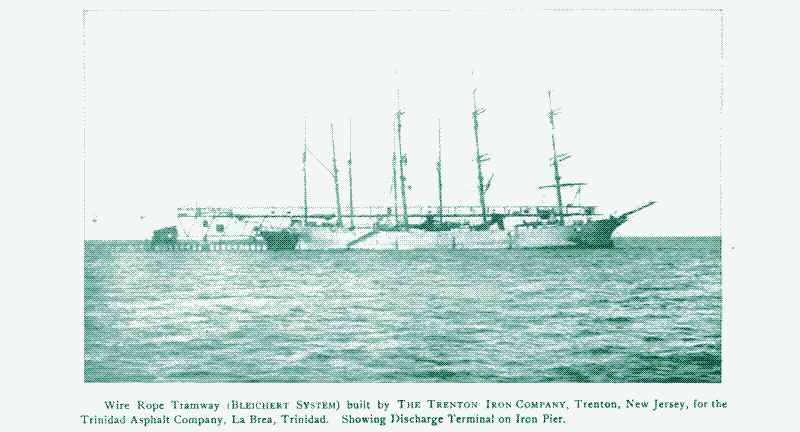
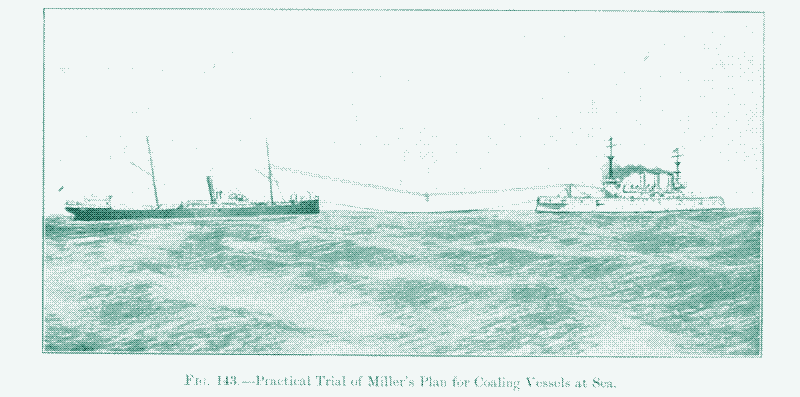
Receptacles
For every material carried by a tramway, there was a specially designed carrier receptacle. Below are some examples for minerals, produce, manure, coke, sacks of flour, textile goods (protected from the weather), cement, petroleum, wine and beer. Some of these carrier receptacles were unloaded by striking a catch, causing the bottom to open or the whole receptacle to capsize or tip up. Loading was mostly (though not always) done by hand.
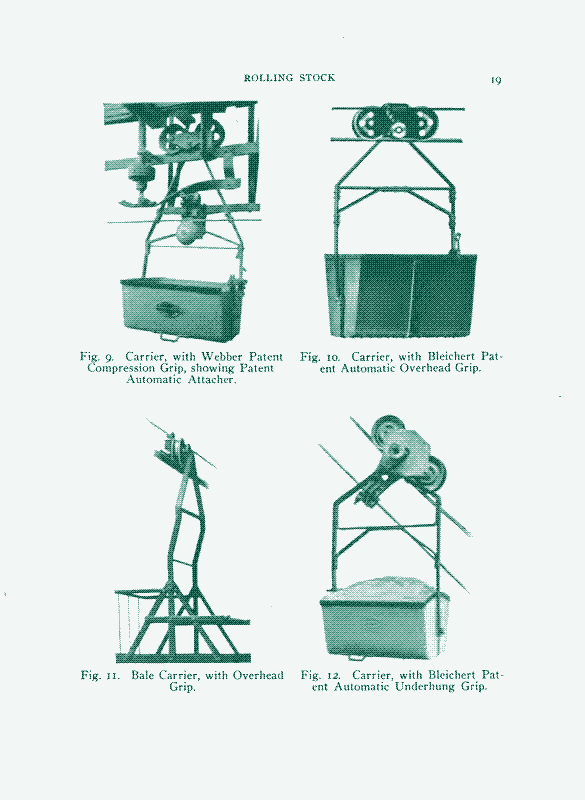
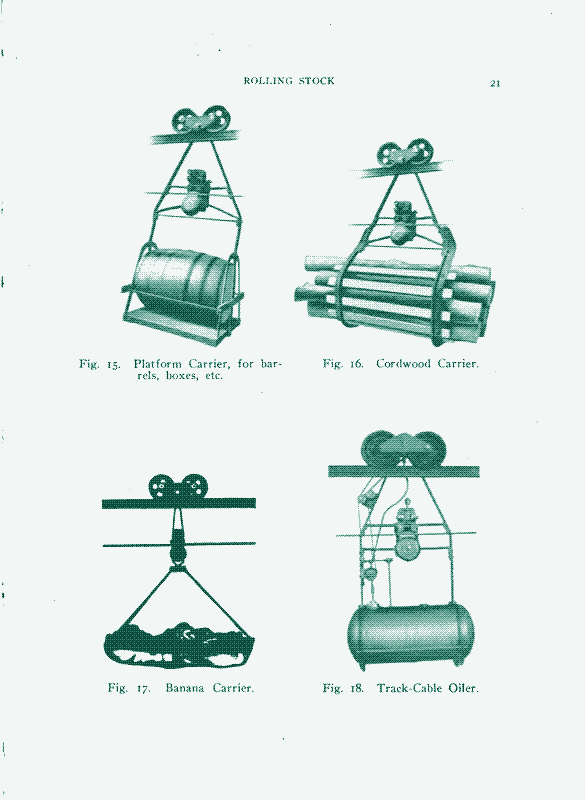
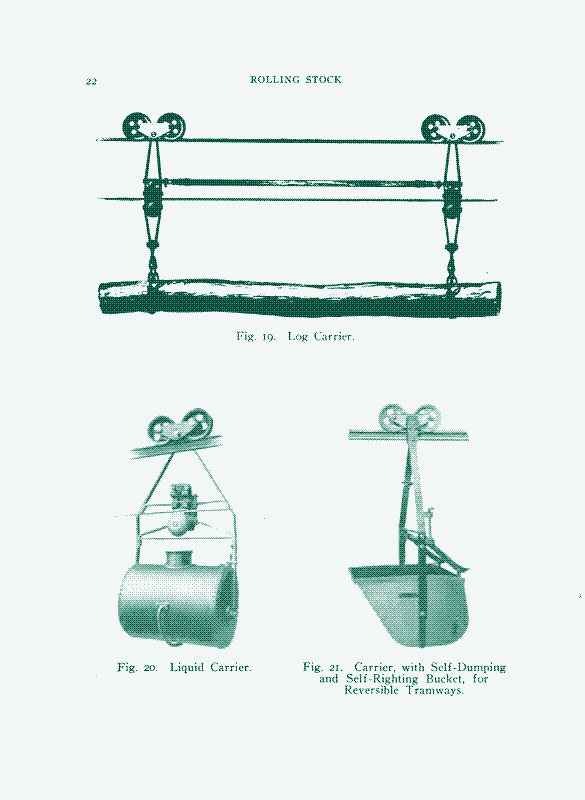
Length, speed and capacity of the lines
Lenghth, speed and capacity of aerial tramways gradually increased throughout the century. In 1911, aerial ropeway lines were typically 1,000 to 15,000 feet (305 to 4,600 metres) long, with a daily cargo capacity of 15 to 200 tons and speeds of around 2 to 5 mph (3,2 to 8 km/h). Some gravity powered installations were faster, with speeds around 15 to 30 mph (24 to 48 km/h), but higher speeds were considered to be a negative influence on wear and tear. Weight of the individual loads varied from 25 to 375 kilograms.
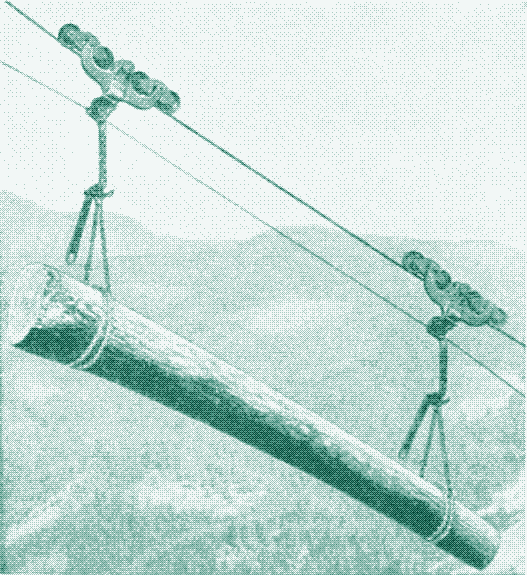
Motive power, if applied, was generally from about 2 to 15 HP. The fall was between zero (almost horizontal lines) and 4,000 feet (1,220 metres). Working staff amounted to 2 to 5 people. Some lines were built parallel to each other in order to increase cargo capacity (the maximum capacity of a single ropeway was about 800 tonnes per day). Some early ropeways were longer and more powerful. The Usambara ropeway in Africa was 5.6 miles (9 kilometres) long and transported tree trunks weighing up to one tonne each (picture above). At its highest point, the ropeway was 130 metres above the ground.
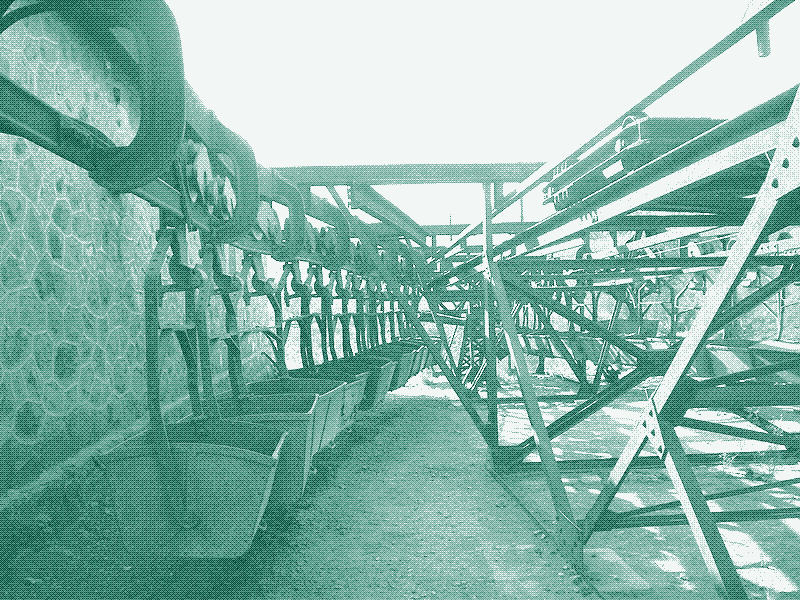
The Garrucha ropeway, an installation at iron ore mines in Almeria, Spain, was 9.75 miles (15 km) long. The construction of the line took only 6 months. It had a daily transport capacity of 420 tons (working ten hours per day), powered by a 100 HP engine. Similar tramways were built in mines in Basque country, north-western Spain (two pictures below).
The Transylvanian wire ropeway, an installation at blast furnaces in Hungary transporting charcoal and ore, was nearly 19 miles (30,6 km) in length, and had a fall of almost 3,000 feet (915 metres). Capacity was around 800 tons per working day. A ropeway in Argentina (picture above), in operation from 1906 to 1927, was 21.3 miles (35 km) long.
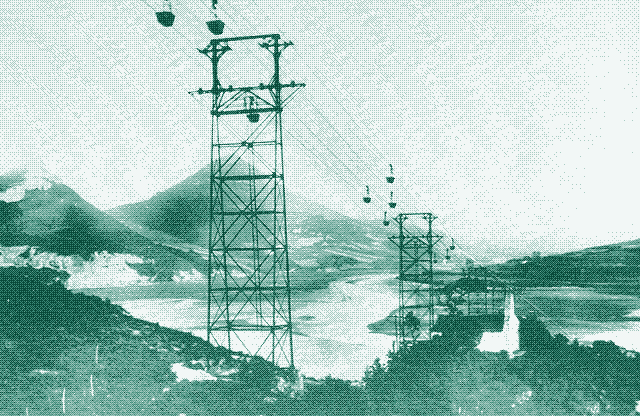
The 1920s saw the construction of even longer ropeways. The longest in Europe was the line erected in 1925 in Granada, Spain. It was used to carry goods from the city to the harbour in Motril over a distance of 39 kilometres. The infrastructure consisted of 240 towers and 7 stations. The 300 vehicles with a loading capacity of 700 kg each travelled at a speed of 3 metres per second.
After the ropeway was built, the port of Motril quickly attracted more traffic. In 1929, an additional 200 vehicles were added to the line. Interestingly, the Granada ropeway was a public service - anybody and everybody could make use of it. Operations ceased in 1950, following the demise of local industry and agriculture.
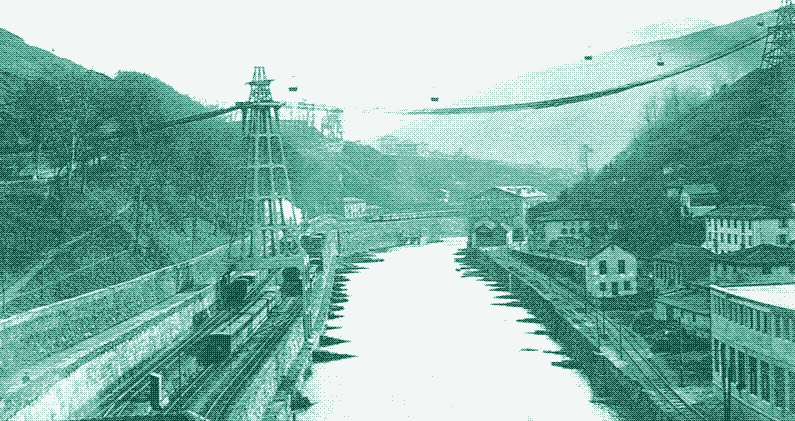
The longest cargo tramway in the world during the 1920s was used for the transport of coffee from Manizales to Mariquita, Colombia. More than 800 vehicles travelled on the 72 kilometre line (45 miles), which was supported on more than 400 towers. The ropeway was opened in 1923 and remained in service until 1961.
The 1930s and 1940s saw the construction of the longest ropeways ever built, with lengths of up to 96 kilometres (60 miles).
The 1930s and 1940s saw the construction of the longest ropeways ever built. The Swedish Forsby-Köping limestone ropeway was the longest in Europe at the time of construction (42 km or 26 miles, in operation from 1939 to 1997), but this record was beaten by the 96 km (60 miles) long Norsöj aerial tramway, also in Sweden. It had 514 towers and 25 tension stations.
This tramway, which was in operation from 1943 to 1987, was built in just 370 days and is the longest cableway ever constructed. The Massawa-Asmara ropeway in Eritrea, built by the Italians, was 75 km (46.5 miles) long and was used from 1937 to 1941. In 1959, a 76 km long cableway with 858 support towers started operation in the Republic of Congo. It remained in use until 1986, operating 24 hours per day.
Transport infrastructure
Ropeway towers could be constructed from timber or iron and were generally between 100 and 300 feet (30 to 90 metres) apart, although much longer spans were possible if necessary. In bicable ropeways the tension in the track cables was produced by weights applied at one of the terminal stations. However, in longer lines it became necessary to apply additional tension at intermediate points.
For this purpose tension stations were built at distances of about 3000 to 6000 feet. The cars passed from one section of the cable to the next by means of intervening rails - so that no interruption occurred in the continuity of the track. This means that there are no limits to the length of a ropeway: each (longer) ropeway consisted of multiple sections that could be considered as separate ropeways.
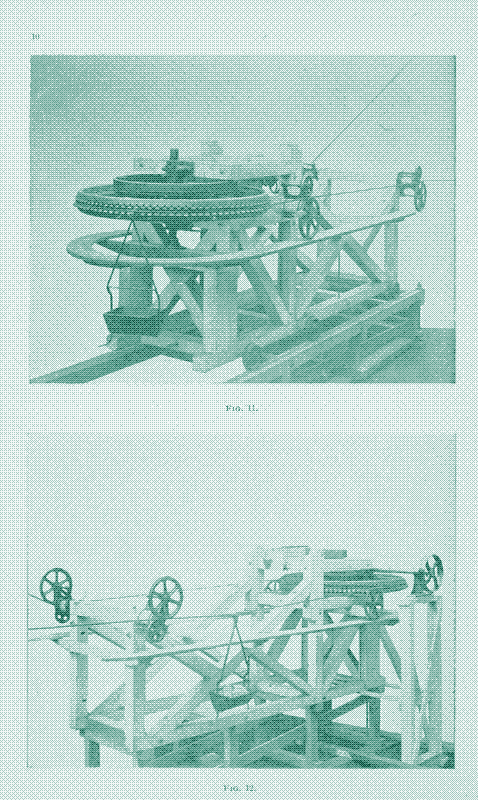
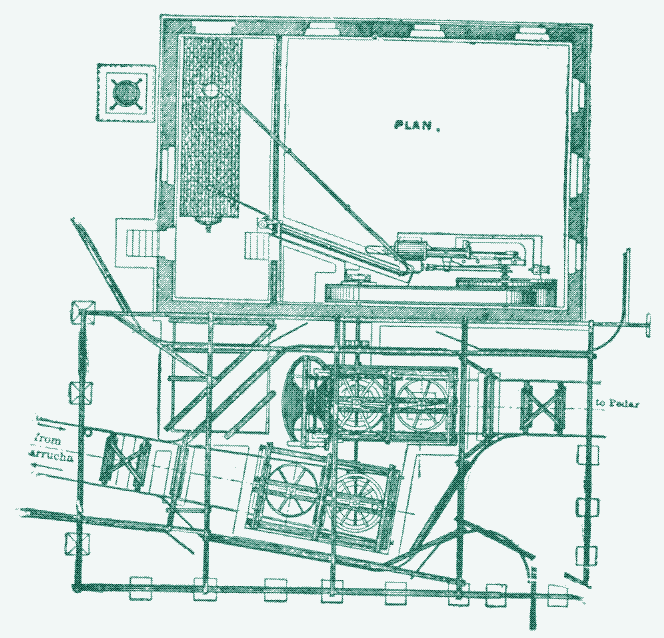
The same technique was applied to “angle stations”, which were used to make a curve in a ropeway (tension stations and angle stations could be combined - see the illustration above). The largest drawback of an aerial tramway, also relevant today, is that it can only be built in a straight line. Every angle in a ropeway requires the erection of an angle station, which raises capital costs. However, in general, few angle stations are needed because ropeways can be constructed above most obstacles.
Moreover, each tension and/or angle station can also double as a loading or unloading station. Goods could even be sent along different routes via a switch if more ropeways met at a single point. The picture above shows a ropeway switchyard of a German coal plant (described in a 1914 book) where three lines of carriers converge.
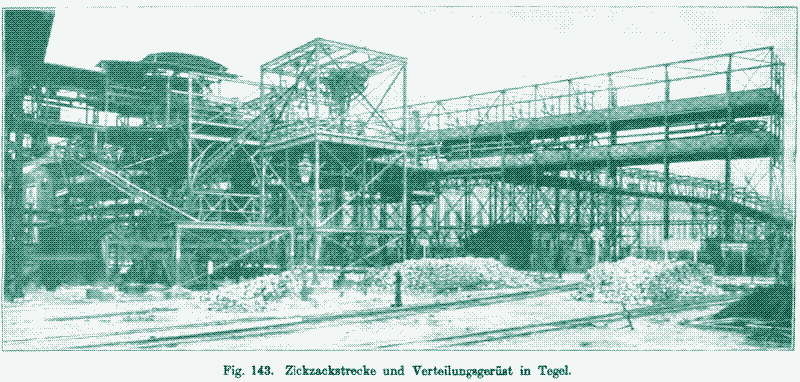
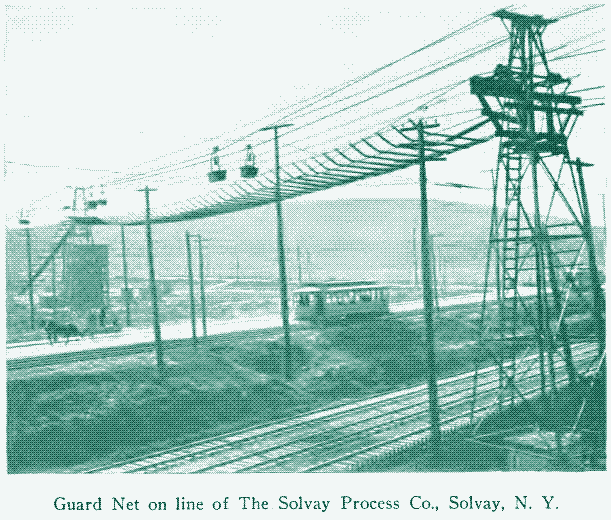
To guard against the risk of accident from the premature discharge of a bucket or other cause when crossing public highways or railroads, wire nets were usually suspended between supports on either side, or structures especially erected for the purpose. An arrangement of a shelter bridge as required by a county council to hide the cableway where it passed over a public road can be seen on the right.
Installing a ropeway
Instalment of ropeways in the mountains was not an easy task. The long rope was usually shipped on reels holding several thousand feet, but where the upper part of the line was inaccessible to wagons, the rope, like the rest of the machinery, had to be packed so that it could be loaded on mules.
Each animal carried about 250 pounds (115 kg) - including the piece of slack rope fifteen or twenty feet long connecting its load to the next one in the rear. This piece was usually held up by a walking person so that it would not drag on the ground.
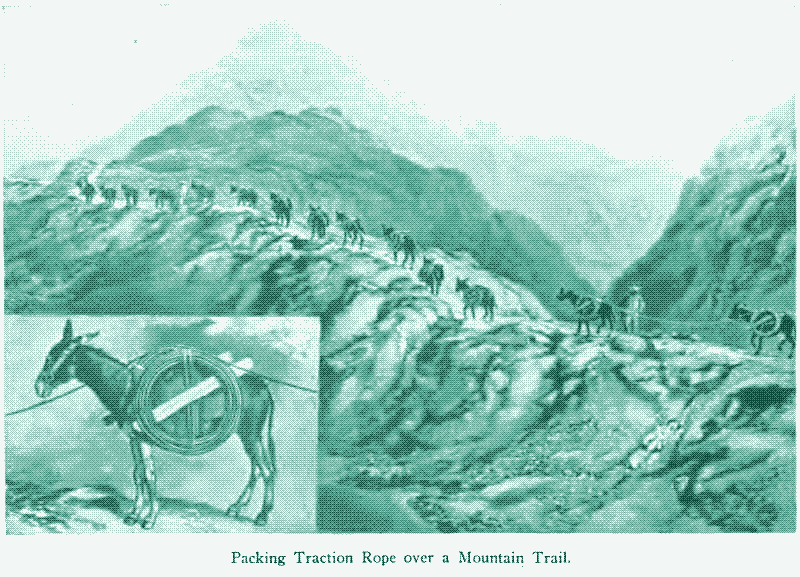
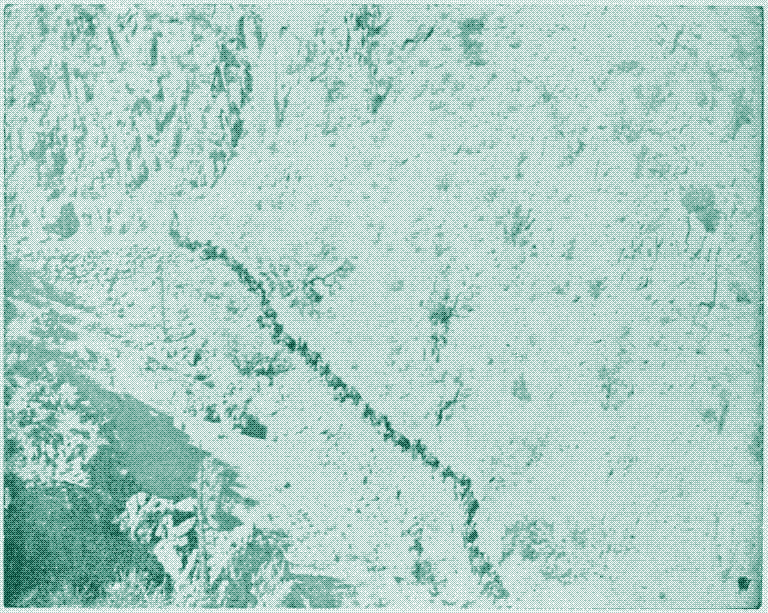
Accidents happened, of course. A 2 mile long ropeway in Mexico for conveying wood to a mill had a fall of 3,575 feet. The constructor notes:
“The transport of this rope was, owing to the rough nature of the country to be traversed, a matter of very serious difficulty. It was accomplished by dividing the rope into ten lengths, each length made up into seven coils, with an intermediate length of ten feet, and each of the coils was loaded upon the back of a mule, the entire train being composed of 70 mules and three men being provided to each seven mules, or thirty men altogether.”
“During the conveyance of the section of rope to the upper terminal an accident occurred which was productive of very considerable delay, and demonstrated the difficulties attendant upon the operation. The head mule, at a point where a rise immediately followed a steep descent, started to take the rise with a rush until checked by the rope, which threw him backwards over the bank, he taking two other mules with him, and had not the last of these caught on a tree, the rest of the train would have followed.”
The many advantages of ropeways
Why did aerial ropeways become so successful at the turn of the twentieth century? The main reason was that they were considerably than their alternatives, be it transport by horses and carts or transport by railroad. The ropeway was economical in operation and required only a minimal capital outlay.
The investment that would be entailed in a hilly country by the necessity of making tunnels, cuttings and embarkments for a line or railway was avoided. A cableway could be constructed and worked on hilly ground at a cost not greatly exceeding that which would be called for on a level country. Rivers and ravines could be crossed without the aid of bridges. Gradients quite impractical to ordinary railroads could be worked with ease.
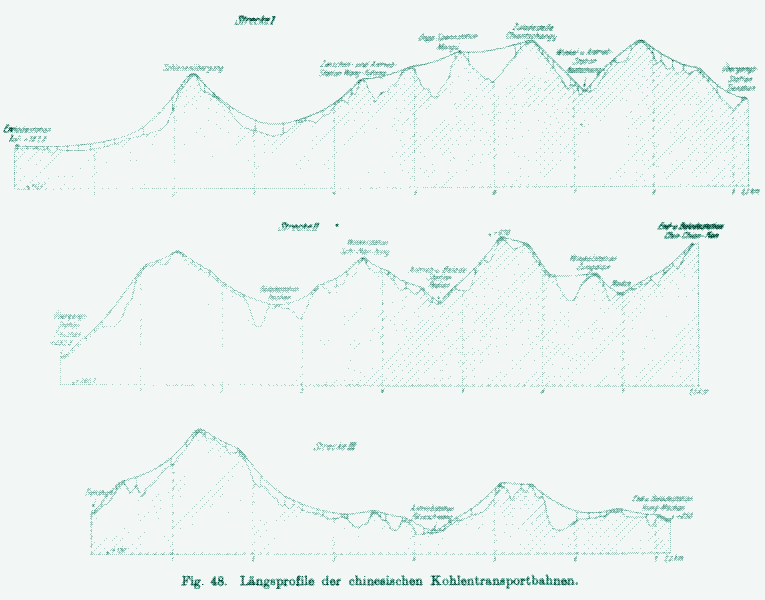
One calculation showed that a ropeway only 1 mile (1,630 metres) long with a difference in altitude of 0.4 miles (645 meters), would require a railway of 15 miles (24 km) to reach the same point. Ropeways were also generally half as expensive to operate when compared to cartage by mules, horses, and oxen.
Furthermore, an aerial tramway could be up and running in no time. Some lines could be easily moved from one place to another with comparative ease. An installation of 1 mile length at a beetroot farm in Holland, with a daily capacity of 50 tons, could be taken down and put up again in a fresh place in one day, by the aid of 20 men, provided the distance to cart the component materials did not exceed 5 miles.
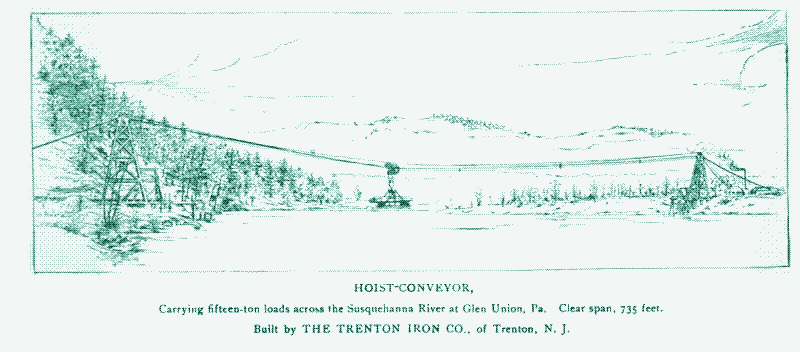
Ropeways continued to work during weather conditions that would bring surface hauling to a standstill (like floods or heavy snow, especially interesting in mountain areas) and they could be operated at night without hazards. Wear and tear were relatively low. Ropeways did not occupy any material quantity of ground, and the intervening land between posts could be left for cultivation or other use.
Terminals could be arranged so that the material transported could be delivered at the exact spot where it was needed, saving all the expense of rehandling. One disadvantage thet ropeways had was that they were more vulnerable to high winds and electrical storms than other transportion options.
Cargo tramways today: renewed interest
The advantages of aerial cargo ropeways are so numerous that it is no surprise that they are - slowly - being rediscovered. Worries about global warming, peak oil and environmental degradation have made the technology even more appealling.
This does not only concern energy use: contrary to a road or a railroad track, a cargo ropeway can be built straight through nature without harming animal and plant life (or, potentially, straight through a city without harming human life). Traffic congestion also plays into the hands of cableways, because the service is entirely free from interference with surface traffic.
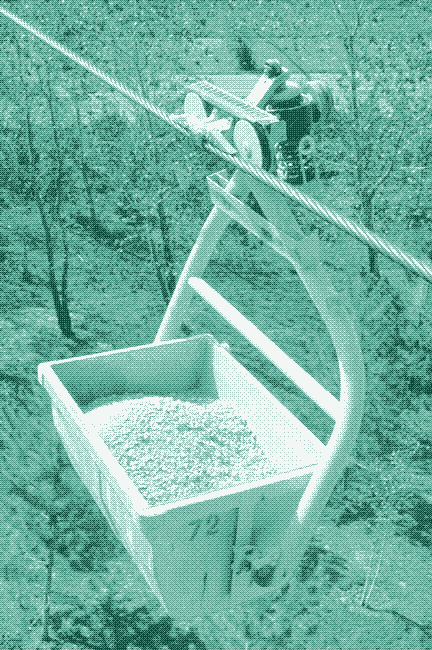
Practical Action has been designing cargo ropeways in Latin America for some time now as an appropriate tech solution. In this case, aerial ropeways are mostly a substitution for pack animals, as they were one century ago in Europe.
In 2007, another non-governmental organization built a gravity powered cargo ropeway in India that serves 2,000 families. It costs just 14,000 dollars and transports agricultural produce downhill while taking manure to fertilize the fields uphill (a very wise thing to do).
Some companies have started offering commercial cargo ropeways again. One of these is Femecol, a Colombian enterprise that offers relatively small-scale solutions. But the big guys are moving, too. French company Poma, one of the largest manufacturers of chair lifts, gondola lifts, funiculars and people movers, has constructed industrial applications of ropeways in France, Brazil, Iran and Peru. In these and in the follwing applications, aerial ropeways are mostly a substitute for cargo transportation by trucks.
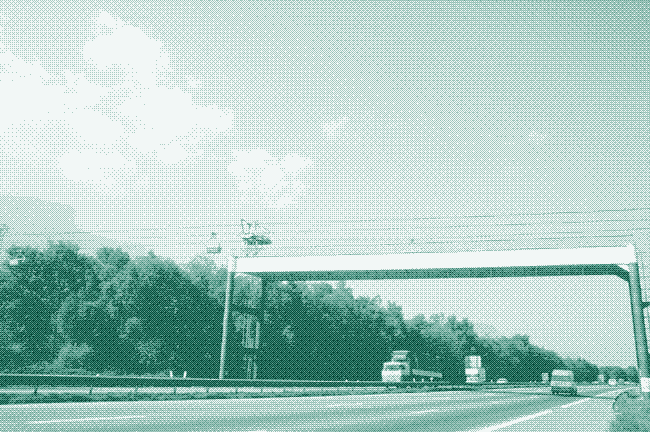

The first modern Poma cargo tramway was built in 1990 in Grenoble, France. It is operated for a cement factory and crosses a river and a motorway (pictures above). The line is 1.8 km long, climbs 121 metres and can handle 324 tonnes per hour - a capacity that is considerably higher than that of older systems (though the line is rather short). Each of the 56 vehicles can hold 900 kg and travel at a maximum speed of 18 km/h.
More recently, a similar cargo ropeway was built in La Oroya, Peru for the lead, zinc and copper mining company Doe Run. It has a similar length to the line in France but climbs 1.65 km (pictures below). It is much slower (5.4 km/h) and it has a lower capacity (70 tonnes per hour - similar to the capacity of the larger systems built in the first decades of the twentieth century).
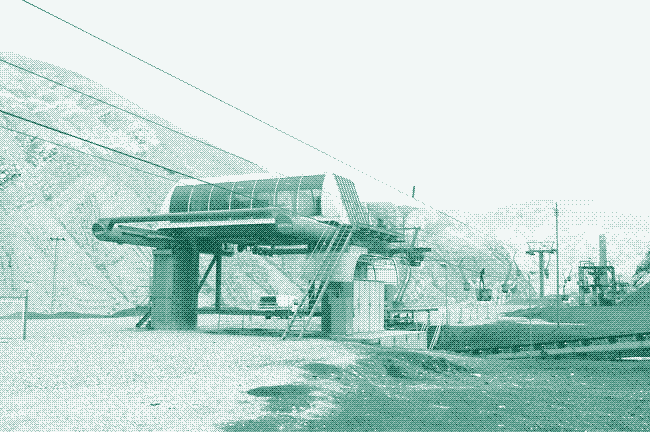
It should be said that the ropeway - which replaced a much older system with a smaller capacity - seems to be the only sustainable element of the mining company, because Doe Run is in hot water with local environmentalists.
Innovation: the RopeCon system
The main competitor to Poma, the Austrian/Swiss conglomerate ‘Doppelmayr Garaventa Group’, takes cargo tramways even more seriously. On their website, they offer cargo ropeways with lengths of up to 10 km, transport capacities of up to 1,500 tonnes per hour and individual loads of 40 tonnes. A temporary, 2 kilometre long system is being built to help in the construction of a pumped storage hydropower plant in Switzerland. But the company also designed a new concept that further improves upon the cargo ropeway: RopeCon.
Mining Weekly describes it as “a bulk material and unit load handlling conveyor, which combines the benefits of well-proven ropeway technology with those of a conventional conveyor belt”.
The RopeCon system in Jamaica saves 1,200 truck journeys per day and generates 1,300 kWh of braking energy per day, which is fed back into the power network.
Some of the advantages over the traditional ropeway are a higher load capacity, better wind resistance, and the need for fewer towers (which makes the lines even easier to integrate into existing terrain). The overhead conveyor system consists of a belt with corrugated side walls and integrated sets of wheels that run on fixed anchored track ropes, guided over tower structures. Individual sections can be built up to a length of 20 kilometres, with a maximum transport capacity of 10,000 tonnes per hour. To date, about 6 lines have been built.
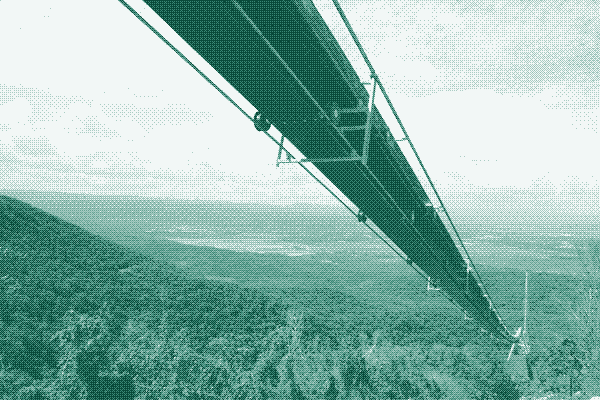
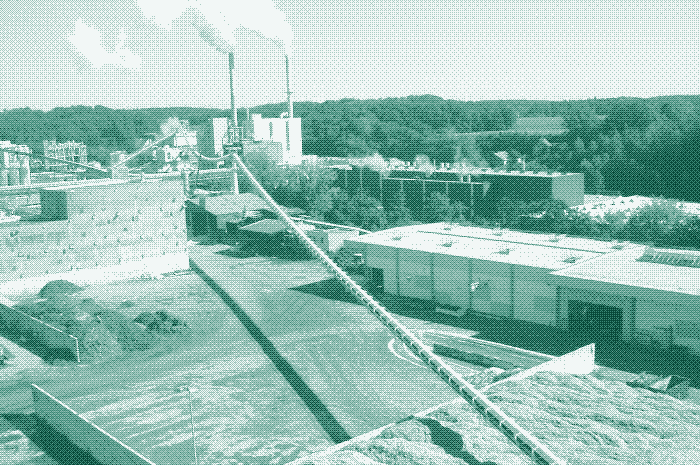
The most spectacular system, which has been tested in hurricane winds of 249 km/h, was built in 2007 for a Jamalco/Alcoa bauxite mine on Mt Olyphant in Jamaica (picture above). It is 3.4 kilometres long and has a vertical descent of 470 metres. The installation conveys some 1,200 tonnes of bauxite per hour from the mine to the processing plant, saving about 1,200 truck journeys per day and generating about 1,300 kWh of braking energy per day, which is fed back into the power network. The transport network thus doubles as a renewable energy plant.
Another remarkable cargo installation is the RopeCon for fiber manufacturer Lenzing, which is used for the transport of wood chips from the storage area to the processing plant. The 665 metre long automatic transport system crosses existing plants and conveyor systems, a river and several roads with minimum tower structures (pictures above and below).
The ropeway conveys 350 tonnes per hour, and although the system does not generate energy because it is built on flat terrain, the engine output is only 53 kW - similar to that of a small car. The line was designed to guarantee 100 percent availability at wind speeds of up to 130 km/h.

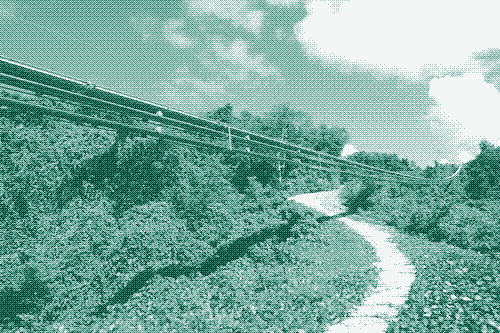
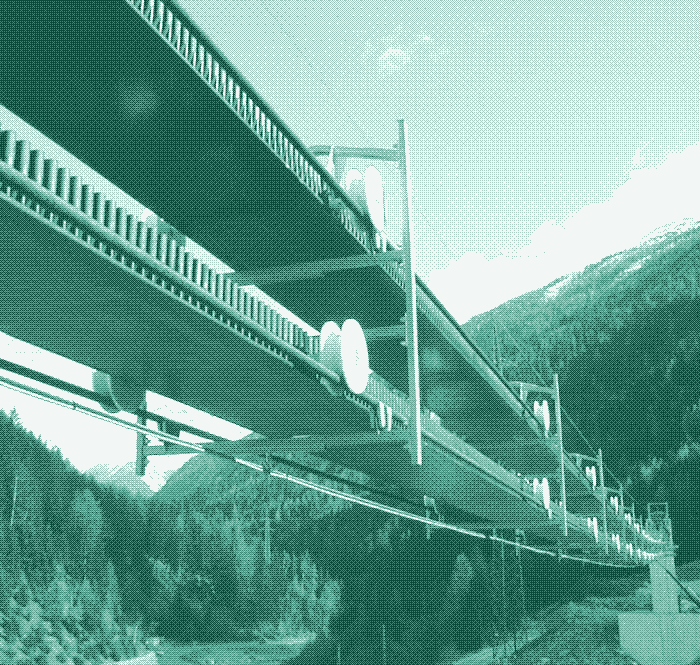
Since May 2008, a system on the island of Simberi in Papua New Guinea transports gold ore over a distance of 2.7 km while using only three support towers over the entire length. The ore is transported from the mine in the interior of the country through the tropical rain forest and fissured terrain to the smelting facility at the harbour. The vertical rise is 237 metres. Transportation capacity is 450 tonnes per hour and the system generates 221 kWh of energy per day through braking power, which is utilized in the gold refinery.
A temporary RopeCon installation was set up for the construction of a tunnel in Austria, where it was used for the transport of rock excavation material. Conveying capacity was 600 tonnes per hour, while engine output was very modest at 30 kW. The line was 270 metres long, with a vertical rise of 23 metres. It eliminated 115,000 truck journeys.
The future of ropeways
It would be perfectly possible to construct similar lines all over the place and get most cargo traffic off the road - not only when it comes to gold or bauxite mines. A cargo tramway could be built from a train station or parking lot outside the city to a shopping mall, or along the motorway between two towns or cities.
We could send produce from agricultural fields and goods from factories straight into shopping districts or into a moored ship, without ever touching the ground. There would be no delays due to gridlocks or traffic accidents. Noise and vibration would be minimal. The low energy requirements could easily be met by renewable, stationary energy sources. In short, a ropeway offers all the benefits of an underground freight network without the enormous capital costs.
We could even build a fully-fledged local, regional or even national or international transportation network of cableways using switch stations that would be cheaper in capital and operational costs than any other alternative (including trolleytrucks, cargo trams, trains and cable cars).
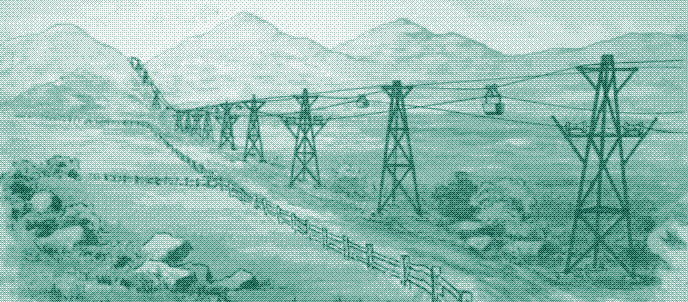
Of course, yesterday’s ropeways are not suited to handle today’s freight loads. For example, today, 400 trucks of 30 tonnes each drive up and down daily between Granada and the harbour in Motril, Spain. That is a total load of 12,000 tonnes, while the local ropeway that was in operation from 1925 to 1950 had a capacity of only 210 tonnes per day (for 10 working hours).
However, as noted, Doppelmayr now offers cargo tramways with capacities of up to 1,500 tonnes per hour, which would be more than enough to get all trucks off the road again. RopeCon systems offer even higher capacities. On the other hand, lowering demand for cargo transport would defenitely make ropeway technology a more realistic option, just as lowering energy demand would surely help the greening of the energy infrastructure.
Ropeways won’t work everywhere, and they are most advantageous in mountainous or moderately level regions. This is not only because a vertical rise can turn the ropeway into a power generator instead of a power consumer, but also because the alternatives (rail, road) are more expensive and complicated to build than on level terrain.
Nevertheless, even on flat ground a cargo ropeway could be a more sustainable option than most other alternatives. The only motorized transport option that seems to be able to compete with the ropeway in terms of both capacity, efficiency and cost is canal transport - even more so if trolleyboats were used. Canal transport is best suited for level regions and thus perfectly complementary with cableways. And what about those trucks? They are so twentieth century.
Sources:
- “About ropeways”, The Information Center for Ropeway Studies
- “Hercules Aerial Tram Mobility Study & Report”. Investigates a wider application of passenger ropeways, but also has interesting information on cargo ropeways.
- “The wire rope and its applications”, 1896
- “Ropeways”, The Elevator Museum, website
- “Aerial or rope-ways: their construction and management”, 1911
- “Transport by Aerial Ropeways”, W.T.H. Carrington, The Engineering Times, 1899
- “Die Drahtseilbahnen”, 1914
- “Chemins de fer funiculaires - transports aériens”, 1894.
- “Wire rope tramways with special reference to the Bleichert patent system”, Edmund Gybbon Spilsbury, 1890.
- “Wire rope transportation in all its branches”, Trenton Iron Co. 1896
- “The Bleichert system of aerial tramways”, 1909
- “Across the Chilkoot pass by wire cable”, William Hewitt, 1898
- “El cable Dúrcal-Motril (Granada)”, Francisco Calvo Poyo, Universidad de Granada.
- “The Hallidie endless wire ropeway”, California Wire Works, 1902
- “Un po’ di storia degli impianti a fune”, Associazione Nazionale Italiana Tecnici Impianti Funiviari.
- El bandido que asaltaba el cable más largo del mundo.
- “The genius of China: 3,000 years of science, discovery and invention”, Robert Temple
- “Science and technology in China”, Volume IV:3, Joseph Needham.
Reactions
To make a comment, please send an e-mail to solar (at) lowtechmagazine (dot) com. Your e-mail address is not used for other purposes, and will be deleted after the comment is published. If you don’t want your real name to be published, sign the e-mail with the name you want to appear.
Reactions
Kris De Decker
Jim,
Aerial ropeways are never considered when comparing different transport modes, so this information is not available to the best of my knowledge.
However, it seems certain that they are cheaper to build than anything else. And in mountains, it seems obvious to me that they are more efficient to operate than canal boats or trains, both options that work best on flat terrain.
Cargo capacity is dealt with in the last part of the article.
Michelangelo Du
Dear Mr. De Decker,
This might be of interest to you to — its a proposal for a macro-engineering project using catapults, tramways and gliders to shuttle people in Indonesia. Please check it out here:
http://arxiv.org/ftp/physics/papers/0701/0701099.pdf
stenius
Very good read, i was surprised that ski lifts were not mentioned anywhere, i would assume that these would fall into this class of aerial ropeways.
Brendan Buggeln
The principle of ropeways doesn’t seem far from that of conveyor belts, a very commonly used technology in many industries. Much of the discussion here was about mining applications. Conveyor belts are also very common in mining and in bulk loading and unloading of materials.
The primary differences seem to me to be that (1) the load is suspended as opposed to supported (almost irrelevant) and (2) the load is in discreet bundles, not a continuous flow. This could be seen as a major disadvantage for ropeways.
I’d be interested to know how the technologies compare in other respects, i.e. in terms of maximum span, wind susceptibility, friction losses, construction cost, etc.
Very interesting article.
John Fisher
Another great article.
@4 you leave out the energy-recovery benefits of the ropeway as described. But possibly a conveyor belt like a flat waterwheel, with buckets or flanges, could provide the same benefit? You can see that over long distances, the extra machinery of a conveyor would be prohibitive, compared to traveling buckets.
Kakungulu
Sorry for my tribal language: http://he.wikipedia.org/wiki/%D7%A8%D7%9B%D7%91%D7%9C_%D7%94%D7%A8_%D7%A6%D7%99%D7%95%D7%9F
This article describes a cable car that was used in Jerusalem, when it was partitioned between Israel and Jordan. The cable ran over the Hinom valley from western Jerusalem (Israel) to an enclave on Mt. Zion. It was first installed during the Israeli-Arab war of 1948-1949 and then remained a military secret until the reunification of the city in 1967. Even when it was still in use (during the war) the cable was lowered to the ground during the daytime so the Arab Legion (Jordanian military) never actually saw it. The Israeli public knew about the secret only in 1972!
Steven Dale
Great article! But you missed the fact that they’ve resurfaced as mass public transit in the last ten years:
http://gondolaproject.com/2010/03/11/medellincaracas-part-1/
http://gondolaproject.com/2010/10/13/the-complexo-do-alemao-teleferico/
Rasmus
This appeared recently and makes a good addition to the topic: http://englishrussia.com/2013/08/21/the-ropeway-city/
Paul Nash
Kris, my hat off to you for another great article, and good to see an old system that is still being built today.
Having worked in the ski industry, I am well familiar with their use there, though I was surprised to learn the “detaching” car has been around for so long. I can also confirm that in British Columbia, Canada, the official term for the ski lifts is “passenger ropeways” regardless of whether they are chair, gondola, tram etc.
I was always amazed at how little electricity these lifts actually used - the 400kW motors usually running at 1/3 output. I can also say the safety and insurance requirements for these (passenger) systems are VERY rigorous.
Cargo ropeways do get used for construction projects, particularly large dams, where, as you indicate, they solve transport problems in mountainous terrain where large dams, by definition, must be located. Mines, however seem to prefer large dump trucks, even though the ropeways make obvious sense in many cases - the mining engineers mostly stick to what they are used to.
I did have occasion to ride an urban mass transit ropeway in Portland, Oregon, USA. It moves 1.1km, up a 150m hill at 35km/h and is far faster than you could get up there by driving, and a much easier alternative to walking, especially in Portland’s rainy climate. http://www.portlandtram.org/faq.htm
For future urban cargo use, it seems the best way is to make them suitable for handling 20 and 40 foot containers, though this would require substantial towers and cables.
There is much scope for cities to make use of these to move people and cargo over self created bottlenecks - may we see more of them!
Sergey Osipenko
I think, the main disadvantage of goods delivery by such kind of transportation is that one ropeway or conveyor belt is less reliable than several vehicles or trains.
What happens if conveyor will stop?
Marian
In 1644 Gdansk/Danzig was part of Polish-Lithuanian Commonwealth so IMO one should use current Polish name Gdansk not Danzig. Danzig was the name from 1308 till 1466 and from 1793 until 1945.
Lewis
Mr. De Decker,
Great article. I was watching a TV show the other day about aircraft carriers in the US Army. They often transport goods from ship to ship using aerial ropeways. Just thought you might be interested.
Björn van der Meer
Thank you Kris, another wonderful article!
Congratulations on getting /.’ed too.
I see you removed the Paypal donation, well done, I also cancelled my account. Check out flattr.com, maybe that would be something for your site.
Greeting from Düsseldorf, Björn.
Steven
Kris,
I know the Hercules study well. It’s a shame it was so poorly done. One of the main problems with the report is that it conflates the terms “aerial trams” and “gondolas” yet the terms mean very different things. Basically the study uses the performance cost package of aerial trams to disprove the viability of a gondola system.
Problem is, the performance cost package of a gondola system is far higher than that of an aerial tram.
Great site, by the way!
Tim Boyden
Definitely a great article discussing the benefits of roped transit. Unfortunately the author fails to provide a balanced bias to the story by discussing the system’s shortcomings. The number one shortcoming, and the reason why we don’t have these systems all over the place, is the cost and availability of land for their implementation. Regardless of whether such a system uses only few peers to support the system; builders/owners of the system would still be required to purchase the land that exists beneath the system, or negotiate an aerial right-of-way with local governments. Neither of which is a cheap or easy thing to accomplish, at least in the United States.
Clearly, train transit is an efficient and cost effective way to move people and goods across the country, but all of your not-in-my-backyard (NIMBA) activists constantly block such projects that could solve most of our transportation problems. It would be no different with a rope system. And if that doesn’t kill your project, the vision of ropes, towers, and cargo/people carriers transiting “scenic communities” (read with sarcasm) will cause much of the population to come out against such a project.
These systems work well in the locations advertised because the local governments control the land and construction decisions in the respective locales. Once you win those politico’s favor, you can proceed without having to worry about the population’s opinion or protests on the matter.
brunurb
My question would be, if the aerial tramways/ropes or whatever you want to call them were installed across the world, what sort of security would there be? I can just imagine pallets of electronics being transported cross-country, and a thief setting up a ladder somewhere in the middle of the cargo’s journey to boost some merchandise. I can’t imagine there would be an easy way to secure the entire distance against this type of thing?
spOOk
Never heard of these before - great comprehensive article and well written.
Slight correction offered:
“This is not only because a vertical rise can turn the ropeway into a power generator instead of a power consumer,”
This is the wrong way around.
Peter
KDD and Lewis,
It is the US Navy that does this. It’s called alongside connected replenishment (CONREP).
Here’s the wiki article on underway replenishment (UNREP).
http://en.wikipedia.org/wiki/Underway_replenishment
A search for UNREP on youtube will pull up a large number of videos of the process.
Peter
new-B
About (24): In the article, vertical fall would be more appropriate than vertical rise.
Thanks for great article, KDD.
Paul Dixon
This is very interesting. But I wonder if the author knew, when telling about the construction in La Oroya, Peru, that oroya is a quechua word for….. rope bridge and the place was so named because there was always a rope bridge across the Mantaro river at this point in Inca times.
Dan Merrick
In 1981 I recall seeing the then operating Hetauda-Kathmandu Ropeway. It was 42 km long and carried goods over the hills to Kathmandu. It was built before there were adequate roads for cargo and continued in use until a few years ago. As I recall, some of the first automobiles in Kathmandu were disassembled, shipped on the ropeway and reassembled.
http://www.indiaoverland.biz/overland/info/ropeway.html
Schneb
Here’s a thought re how to develop use of these systems (note: it involves a military application of this technology, so sorry if that is counter to some readers’ ethical outlook).
U.S. military develops system of mobile raised carbon fiber tram transport (MRCRTT, or ‘Mr. Cart’–gotta have an acronym for military use, right?). This would involve SEABEE type troops, with stockpiled equipment, know-how, etc. who can helo-into-place the towers and lay cables in short periods of time, crossing terrain that otherwise would be physically impassible or where a military presence on the ground would arouse hostilities. A main ’trunk’ ground route could be established as needed with spurs of MrCart transport to hill villages or fortifications (in, Idunno, say, Afghanistan?). Saves having to carve/maintain roads on the mountainsides.
These transport systems would still be vulnerable to attacks, but that means the military will work out how to minimize the effects of a catastrophic failure: brakes/clamp-devices at each tower to sense loss of tension on the line if a neighboring tower were destroyed. The brakes/clamps lock onto the line to keep it from dropping to the ground until it/the cargo on it could be safely lowered. Also, replacement towers would be easily installed, again by helo-transport, so interruptions would be short. That sort of technology/know-how would help in the civilian use, bringing the liability costs for passenger use down.
The mention of a line in Holland that covered a mile or so, but could be moved in a day by 5 men suggests the ease, flexibility of use that would make this useful in a military context.
But also, this could be a back-up to use when a natural disaster/human actions have taken out a bridge.
And lastly, I live in Michigan, near Detroit. There is a single, old bridge connecting Detroit and Cananda. That bridge is insufficient to handle modern traffic. If a carbon fiber tramway carried containers from semi-bed to semi-bed across the river, that would be a much cheaper option than building an entire, new, additional bridge.
I love the idea of this, but am not at all technically savvy. Sorry if my imaginings are stating the obvious or impossible. Thanks for the article and I look forward to exploring this site/magazine. This is the first I’ve seen of it, but it seems very well written and intelligent.
Robert Fairchild
There is an organization doing pedal powered cars on suspended cables in the mountains of Nepal: http://www.villagetechsolutions.org/transportation.html
Myrtonos
If we use ropeways to send goods uphill, could we power them by filling ballast tanks with water for each downhill run?
praveen maranat
Dear sir,
Please give me details for constructing a rope way to carry farm goods weighimg 70 kg in each bucket overa length of 500 meters. I intend to make the rope wat demountable so that the same pillar and the wires can be used in many places.
Please guide me on this.
I still am unable to visualise how a bucket passes over a middle post withour obstruction.
Brgds
Praveen
Richard Tucker
Excellent article. Around the mid 1980’s I worked for British Gypsum at their gypsum mines in East Sussex, England. The company used an overhead ropeway for hauling the rock back to the production facility which if my memory serves me correctly was at least 6 miles distant. There is a photo in the article below that shows it exiting the mine at the start of it’s journey:
http://www.wcms.org.uk/cgi-bin/wcmsarchive.pl?archid=brightling_winter1988
Later the ropeway was replaced by this covered converyor:
http://www.geolocation.ws/v/W/4d4c429b1d41c87cb8010150/gypsum-mine-conveyor-belt-at-brightling/en
Jim Baerg
“Goods could even be sent along different routes via a switch if more ropeways met at a single point.”
Have you run across any images of the sort of switch that could be used? Are they somewhere near as simple as the switches used on two rail railways? I did find some images for monorail switches, which look reasonable, but a bit clumsy by comparison.
Todd Millions
Very good-If you are updating this you might want to see if pictures of the quarry too dam site belt for the construction of the Bennet dam at Hudson Hope BC in the early 1960’s are available(B.C.Hydro may be of use).The belt bearings were greased for a multi year run,and as a child my mind couldn’t encompass how the rocks were being drawn uphill over the ridge.Two years after we left I finally got it!
Terry
Would such a system be viable over the vast expanses of the Canadian Arctic?
Thomas M. Brandow
Great article, after a career in a coal fired power plant, which is all about moving materials, rail cars bring coal in, converyors move coal to crushers and storage bins, air powered piping blowing coal into boilers, slurry pipelines transporting spent slag out to dewater and trucked out for asphalt, flyash air transported to silos, and tank trucked out for concrete. I am renovating my home alone, so it’s all about tearing old stuff out and moving it to be burnt or trashed, picking up by van lumber, drywall, tile, everything carried in or wheeled in….so my life is constantly moving shit from one spot to another, and finding a method to do it saving my back. Love the history.
Hugh Stokes
Here is a little ropeway built by the farmers of a village in the Jura, France. The cheese factory was in the valley, far below a farming hamlet up on the mountain. The weight of the full milk churns was used to haul up the empty churns. It was used for a hundred years, until the early 1980s, and saved the farmers from making a difficult and tiring descent and ascent every day. There is now a society set up to restore it. From France 3 TV, so the commentary is in French.
https://youtu.be/BkiMe5t0iZc
Cavan Mejias
I saw this video the other day: ‘The UK’s last aerial rope-way uses no power, moves 300 tonnes a day, and will be gone by 2036’
https://youtu.be/6RiYXI1Tfu4
Best Regards